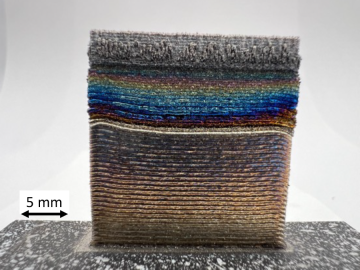
Filter News
Area of Research
- (-) Clean Energy (208)
- (-) Materials (186)
- Advanced Manufacturing (7)
- Biological Systems (3)
- Biology and Environment (119)
- Biology and Soft Matter (4)
- Building Technologies (3)
- Chemical and Engineering Materials (3)
- Chemistry and Physics at Interfaces (7)
- Climate and Environmental Systems (7)
- Computational Biology (1)
- Computational Chemistry (5)
- Computational Engineering (2)
- Computer Science (4)
- Data (1)
- Earth Sciences (1)
- Electricity and Smart Grid (2)
- Energy Frontier Research Centers (7)
- Energy Sciences (2)
- Fuel Cycle Science and Technology (2)
- Functional Materials for Energy (10)
- Fusion and Fission (43)
- Fusion Energy (7)
- Geographic Information Science and Technology (1)
- Isotopes (24)
- Materials Characterization (2)
- Materials for Computing (17)
- Materials Synthesis from Atoms to Systems (8)
- Materials Under Extremes (8)
- National Security (53)
- Neutron Data Analysis and Visualization (2)
- Neutron Science (83)
- Nuclear Science and Technology (35)
- Quantum Condensed Matter (3)
- Quantum information Science (5)
- Renewable Energy (2)
- Sensors and Controls (2)
- Supercomputing (172)
- Transportation Systems (6)
News Type
News Topics
- 3-D Printing/Advanced Manufacturing (38)
- Advanced Reactors (6)
- Artificial Intelligence (8)
- Big Data (4)
- Bioenergy (15)
- Biology (7)
- Biomedical (5)
- Biotechnology (1)
- Buildings (13)
- Chemical Sciences (15)
- Clean Water (5)
- Climate Change (12)
- Composites (5)
- Computer Science (18)
- Coronavirus (8)
- Critical Materials (1)
- Cybersecurity (8)
- Decarbonization (16)
- Energy Storage (36)
- Environment (33)
- Exascale Computing (1)
- Fossil Energy (1)
- Frontier (2)
- Fusion (4)
- Grid (14)
- High-Performance Computing (6)
- Irradiation (1)
- Isotopes (8)
- ITER (1)
- Machine Learning (4)
- Materials (47)
- Materials Science (34)
- Mathematics (2)
- Mercury (1)
- Microelectronics (1)
- Microscopy (15)
- Molten Salt (1)
- Nanotechnology (19)
- National Security (2)
- Net Zero (1)
- Neutron Science (16)
- Nuclear Energy (13)
- Partnerships (6)
- Physics (16)
- Polymers (7)
- Quantum Computing (2)
- Quantum Science (2)
- Security (4)
- Simulation (2)
- Space Exploration (2)
- Summit (3)
- Sustainable Energy (20)
- Transformational Challenge Reactor (3)
- Transportation (24)
Media Contacts

Xiao-Ying Yu, a distinguished scientist at the Department of Energy’s Oak Ridge National Laboratory, has been named a Fellow of AVS: Science and Technology of Materials, Interfaces, and Processing, formerly American Vacuum Society.

Yarom Polsky, director of the Manufacturing Science Division, or MSD, at the Department of Energy’s Oak Ridge National Laboratory, has been elected a Fellow of the American Society of Mechanical Engineers, or ASME.

Research into a new, unique technology to fabricate composite metal parts for a wide range of applications operating in extreme environments across the aviation, space and energy industries is showing promise for additive manufacturing.

Early experiments at the Department of Energy’s Oak Ridge National Laboratory have revealed significant benefits to a dry battery manufacturing process. This eliminates the use of solvents and is more affordable, while showing promise for delivering a battery that is durable, less weighed down by inactive elements, and able to maintain a high capacity after use.

Researchers at the Department of Energy’s Oak Ridge National Laboratory were the first to use neutron reflectometry to peer inside a working solid-state battery and monitor its electrochemistry.

Researchers at the Department of Energy’s Oak Ridge National Laboratory are supporting the grid by improving its smallest building blocks: power modules that act as digital switches.

Creating energy the way the sun and stars do — through nuclear fusion — is one of the grand challenges facing science and technology. What’s easy for the sun and its billions of relatives turns out to be particularly difficult on Earth.

For more than 100 years, Magotteaux has provided grinding materials and castings for the mining, cement and aggregates industries. The company, based in Belgium, began its international expansion in 1968. Its second international plant has been a critical part of the Pulaski, Tennessee, economy since 1972.

Stan David, retired scientist and Corporate Fellow Emeritus at the Department of Energy’s Oak Ridge National Laboratory, was awarded the Joining and Welding Science Award from the Joining and Welding Research Institute at Osaka University, Japan.

Having passed the midpoint of his career, physicist Mali Balasubramanian was part of a tight-knit team at a premier research facility for X-ray spectroscopy. But then another position opened, at ORNL— one that would take him in a new direction.


